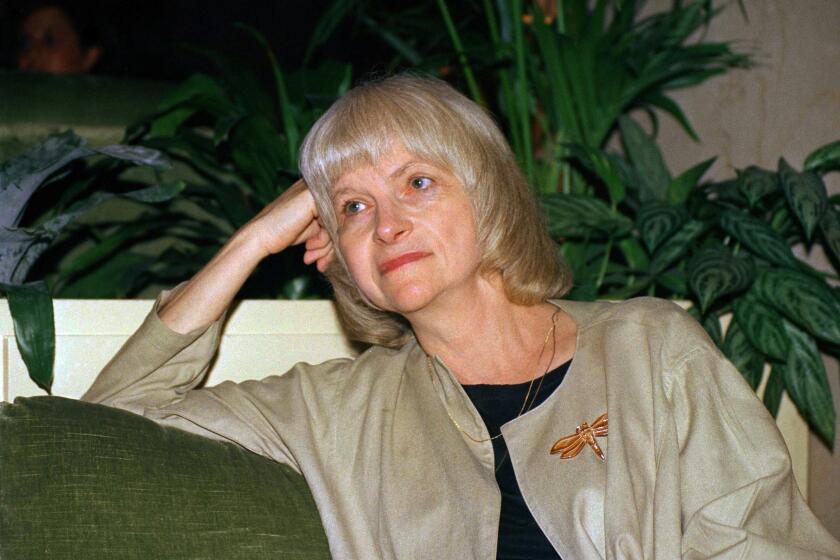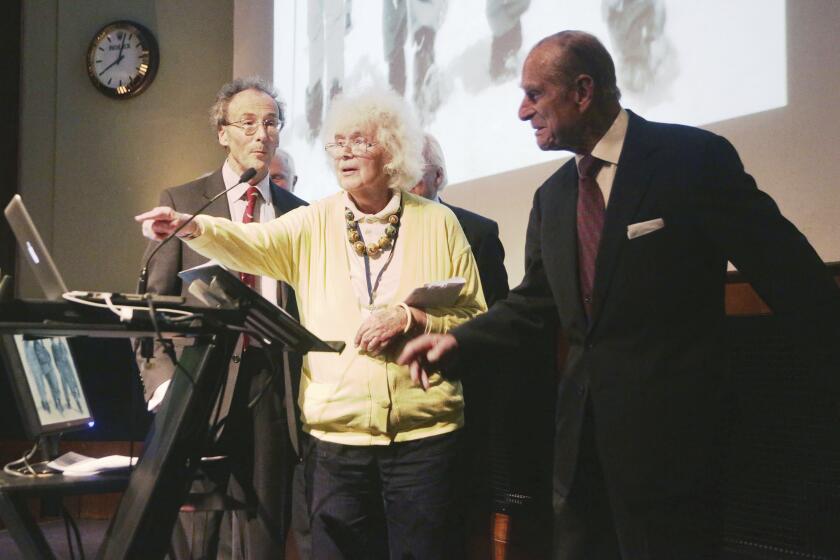Appreciation: An unsung 1966 L.A. satire shows the late novelist Alison Lurie at her wicked best
- Share via
Appreciation
Alison Lurie
If you buy books linked on our site, The Times may earn a commission from Bookshop.org, whose fees support independent bookstores.
Alison Lurie, like her characters, embraced contrarieties. She spent most of her professional life in academia and yet wrote essays on fashion and children’s literature with an acute, sensual prose that you don’t usually find in scholarly journals. She maintained semi-permanent homes in upstate New York (where she taught for decades at Cornell), London and Key West. And her novels explored a wide variety of family and sexual relationships between women and men, women and women, men and men, parents and children, and, in her bestselling, Pulitzer Prize-winning “Foreign Affairs” (1984), that most divergent pairing of all — Yanks and Brits.
Lurie’s novels are fictional Ferris wheels, much like the novels of Jane Austen, whom Lurie clearly emulated. What I mean is that, for example, when Elizabeth meets Darcy, he is riding low on the wheel while another local, Mr. Collins, is riding high; but once she gets to know them better, the wheel turns, the valuation reversed. Lurie’s principal characters, like Austen’s, are always learning to see past illusions until eventually, if they’re lucky, they discover someone they want to spend their lives with.
Novelist Alison Lurie, best known for ‘Foreign Affairs’ and ‘The War Between the Tates,’ has died at 94.
And so Vinnie Miner in “Foreign Affairs” eventually learns that the overweight, boorish American sitting next to her on the flight to London isn’t actually boorish at all. And in the same book, her university colleague and fellow academic-abroad, Fred, learns that his charming, Hampstead-living television actress girlfriend isn’t actually charming at all. Most of the relationships Lurie explored might easily be called “foreign affairs.”
Lurie wrote about places with the same affection and consternation she applied toward men and women. Never were those qualities more evident than in her 1966 Southern California novel, “The Nowhere City.” Drawing on personal experiences from the late ‘50s, when her first husband, Jonathan Bishop, taught briefly at UCLA, Lurie approaches the foreign (to her) regions of Westwood, Hollywood and Venice like any sun-struck and change-averse traveler.
After Katherine and Paul Cattleman move to the West Coast from Boston, their approaches to the land of year-round summers are as divergent as their personalities. Paul, a hedonist, grows quickly acclimated to the brown-skinned, sexy young waitresses and loose working hours; Katherine, far more cautious, just keeps complaining about her sinuses. She calls Mar Vista (where Lurie lived for several years) “a lie … it has no view of anything … ‘Spoil-the View,’ I call it … Everything’s so exaggerated, so unnatural.” And she compares the entire city to a “huge cement donut about twenty feet high” revolving over a doughnut shop near the airport: “that’s what this city is! That’s what it is, a great big advertisement for nothing!”
Yet unlike that harsh apocalypse dealer Nathanael West (whom Lurie admired “tremendously”), Lurie doesn’t enjoy blowing things up; instead, her characters either adapt to conditions and relationships or flee them. Paul Cattleman grows disenchanted with the hipster actresses who all seem more sexually savvy than he is, while Katherine discovers her own pleasurable “somewhere” in the “nowhere city” — acquiring a new career, new lovers and a new understanding of herself through an affair with a manipulative UCLA psychotherapist. It’s a type of progress that many Lurie protagonists enjoy.
I enjoyed my own brief and Platonic Ferris-wheel-like flirtation with Lurie, whom I met several times over the decades and found to be as charming and exasperating as her characters. She stood me up three times after agreeing to three separate reading invitations at universities where I taught; in 1990, she invited me for a pleasant afternoon tea at her lovely flat in St. John’s Wood, after which she soon broke another reading date. Whenever we met or corresponded afterward, she broadly admitted that she didn’t remember any of our previous meetings. But then I couldn’t be hurt or offended by Lurie. She was just busy. Her longtime friend and colleague at Cornell, the novelist Lamar Herrin, called her “a very generous and gracious woman” who “always seemed to know the right detail, the right thing, in a given moment, for a character to say or do.”
From the first time I became a teacher, Lurie was one of the living writers I most wanted to introduce to my students. But even when she didn’t show up, I always had a much better thing to give them: her novels.
Little-known author of “True Grit,” Charles Portis penned inventive stories of con men, losers and seekers of truth. He died Monday at 86.
Despite her bestselling success in the ’70s and ’80s, it seemed to me that Lurie’s critical reputation waned unfairly afterward. In London (where Lurie’s comic view of human failings was especially attractive to the self-conscious British), “The Last Resort” (1986) received several weird negative reviews. I still recall one notable feminist on an evening arts program calling it “reactionary” because the central protagonist returned to her self-centered, much-older writer-husband after a brief affair with another woman. But that was itself an unmissable Lurie theme; her protagonists often realized that what they should be doing didn’t make them happy. Emotional life was too complicated for simple solutions. And while something like divorce could be awful, well — for many of her characters, it was an awakening.
My favorite specimen of a Lurie plot is “The Truth About Lorin Jones,” in which another typically Lurie-esque academic goes searching for the “truth” about a deceased feminist heroine who, she believes, was “held back” by a selfish, less talented husband. (The characters seem vaguely modeled on popular press versions of Sylvia Plath and Ted Hughes.) Eventually, what seems to be true is not what actually happened. The more biographer Polly Alter learns about the real-life Lorin Jones, the less she likes her; and the more she learns about Lorin’s husband, the more she likes him. The Ferris wheel of love never stops turning in Lurie’s fictional universe — especially when it comes to literary reputations.
I will miss reading those excellent novels that came down the pike every eight or 10 years, each consistently surprising. She wrote without any trace of sentimentality, and some people mistook this approach for cruelty or even spite. Way back in 1990, during a job interview for the UCLA English department, I mentioned that “The Nowhere City” was one of my favorite novels. A sudden silence struck our conversation, like one of those earthquake aftershocks you don’t know is happening until it’s over. None of the five interviewers looked up, and at least a couple scowled. Afterward, when showing me to the elevator, the committee chair told me Lurie’s husband had felt he was treated poorly at UCLA; even 30 years later, faculty members considered her novel a form of “payback.”
Jan Morris, the writer and transgender pioneer who died Friday, should also be remembered for her perceptive 1976 essay “Los Angeles: The Know-How City.”
I’ve read the book several times since then, and while it is filled with Lurie’s funny, sharp-sighted appraisals of academics, I never noticed a single moment that seemed pointed, bitter or vengeful. But maybe the truth does that sometimes: it feels threatening simply because it’s truthful.
In my favorite of her nonfiction works, “Familiar Spirits,” a brief memoir of her friends and Key West neighbors, James Merrill and David Jackson, Lurie writes in the concluding pages, “To conjure spirits from the vasty deep of one’s own mind is always dangerous.”
However light or comic they might seem, Lurie’s novels are always dangerous.
Bradfield is the author of “The History of Luminous Motion” and “Dazzle Resplendent: Adventures of a Misanthropic Dog.”
More to Read
Sign up for our Book Club newsletter
Get the latest news, events and more from the Los Angeles Times Book Club, and help us get L.A. reading and talking.
You may occasionally receive promotional content from the Los Angeles Times.










